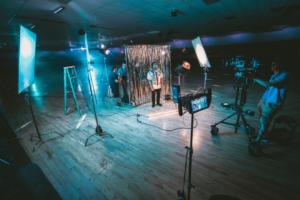A 2nd AC, second assistant camera, second assistant, camera loader, or clapper loader has various tasks including: making sure the slate, or clapper, is in the best spot for the camera, loading raw film stock into camera magazines, marking actors as necessary, and maintaining all records and paperwork for the camera department.
Tasks the 2nd AC is responsible for
- Slating
Displaying the film slate in the best spot for the camera
- Slating
- Loading: Manage Film Stock and Camera Reports
The 2nd AC typically oversees film and memory card inventory and takes responsibility for transporting footage to the digital imaging technician (DIT). On some sets, the loader handles these tasks. - Marking: Make Reference Points for Focus Settings
To help the 1st AC and the camera operator with focus settings, the 2nd AC uses tape to mark the actors’ positions. - Assist With Camera Setups
Although the 1st AC generally moves the camera to new filming locations, the 2nd AC helps with setup by transporting tripods and mounts.
- Loading: Manage Film Stock and Camera Reports
- Charge and Change Camera Batteries
Camera operators often need new batteries at a moment’s notice, so 2nd ACs are responsible for making sure they’re charged at all times. - Transporting Lenses
The 2nd AC often assists with changing and transporting lenses. To do this job well, the 2nd AC has to be able to handle lenses without smudging or damaging them. - Equipment Management: Maintaining the Camera Cart
Film crews may need certain cameras or related accessories at any time. The 2nd AC has to organize the camera cart and locate or transport equipment efficiently. - Maintaining Monitor Feed
The 2nd AC ensures that the director has access to a monitor feed, including attaching cables and securing power. - Paperwork
In addition to handling equipment and technical tasks, 2nd ACs manage paperwork. From filling out timesheets to tracking petty cash, they have to stay organized. - Assisting the 1st AC: Relieve the 1st AC
Along with standard responsibilities, 2nd ACs also support the 1st AC by setting up the camera and managing equipment. - Listen to the DP as Much (or More) Than the 1st AC
The 2nd AC should listen to the director of photography (DP) carefully in order to tackle tasks proactively. - Double Check Their Double Checks
To support the 1st AC effectively, the 2nd AC should double check battery levels, focus marks, lens exposure, and other aspects the 1st AC handles.
What Skills Does Second Assistant Camera Need?
To succeed as a 2nd AC, you need at least basic camera skills. You should also have excellent communication and organization skills so you can work smoothly with the camera crew.
Education and Training
Most 2nd ACs go to film or trade school to get a foundation in the film industry. You don’t usually need a four-year degree for this role, so most aspiring camera crew members pursue a one or two-year degree instead.
Personality
Although many 2nd ACs are ambitious, it’s important to follow rules and understand etiquette in this role. You should also be positive and willing to assist any members of the crew so the filming process can go smoothly.
My Personal Kit
As a 2nd AC, you can expect to provide your own tools and equipment. A standard 2nd AC kit might include:
- Multipurpose tool
- Utility knife
- Scissors
- Multicolored tape
- Screwdriver
- Allen wrenches
- Pens and pencils
- Notepads
- Flashlight
- Lens cloth
Getting Started
Members of the camera crew normally follow a set career path. Find out how 2nd ACs usually get their start and how they land more advanced roles:
Employment
Many 2nd ACs start out as camera trainees or production assistants (PAs). In these roles, you can get hands-on experience operating a camera and working on a film set. You can also meet camera operators and other crew members who can help you get more jobs.
The Best 2nd ACs Make Themselves Indispensable
To land higher-paying positions, 2nd ACs have to make themselves indispensable on the set. Going above and beyond to anticipate and meet crew members’ needs can help 2nd ACs catch the eye of the camera operator or the DP, which in turn can increase their chances of getting more or better jobs.
Do Your Job as a 2nd AC Better Than They Could
To excel in this role and get the attention of the 1st AC, strive to be the best possible 2nd AC you can be.
Advancement
With experience, a 2nd AC can typically advance to higher-paying roles. Many eventually become 1st ACs, camera operators, or even directors of photography.
Lifestyle
Most 2nd ACs are freelancers, which means every job could be different. Many 2nd ACs have to work 12-hour days, which may be overnight or on weekends.
Unions, Groups, and Associations
Second ACs often join a local chapter of the Camera Assistants Union. As a member, you can better secure fair pay and safe working conditions.
Other Film Careers to Consider
Most film crews require dozens of capable professionals. Take a closer look at some other camera crew jobs:
Director of Photography
The DP oversees the camera and lighting departments as well as the electrical and grip crew. They liaise between the crew and the director.
Camera Operator
The camera operator runs the camera. The person in this position may also double as the DP.
First Assistant Camera (1st AC, Focus Puller, Assistant Cameraman, B Camera): 1st AC Duties
The 1st AC reports to the camera operator and delegates tasks to other members of the camera crew, such as the 2nd AC. A 1st AC’s responsibilities include:
- Preparing and testing camera equipment
- Formatting media
- Maintaining camera settings
- Hiring members of the camera crew
Loader (Film Loader, Digital Loader)
The loader manages memory cards and film stock, including overseeing inventory and digital storage. On many film sets, the 2nd AC doubles as the loader.
Digital Imaging Technician (DIT)
The DIT is in charge of data and file management, including backing up footage and providing it to film editors. They also handle digital quality control and tend to have advanced technical knowledge.
Steadicam Operator
This camera operator controls the Steadicam rig on set. Steadicam operators have to wear the rig, which requires physical fitness and technical know-how.
Camera Production Assistant (Camera PA, Camera Intern, Camera Trainee)
Camera PAs support the camera crew. They assist the DP, camera operator, and other members with tasks as necessary.
FAQ
Learn answers to common questions about 1st AC and 2nd AC jobs:
How Much Does a 2nd AC Make?
A 2nd AC makes an average of $50,600 per year. Annual salaries range from $42,000 to $62,000 and don’t include employee benefits.
Are There Other Camera Assistants?
Most film crews include a 1st AC, who oversees the 2nd AC. Film crews can also include a camera PA.
What Skills Does First Assistant Camera Need?
To become a 2nd AC, you need these skills:
- Attention to detail
- Communication
- Organization
- Physical stamina
- Teamwork
What Do You Think?
It’s easy to take the first step toward a career in film. Request information about the Nashville Film Institute’s filmmaking program and learn how to get started today.













